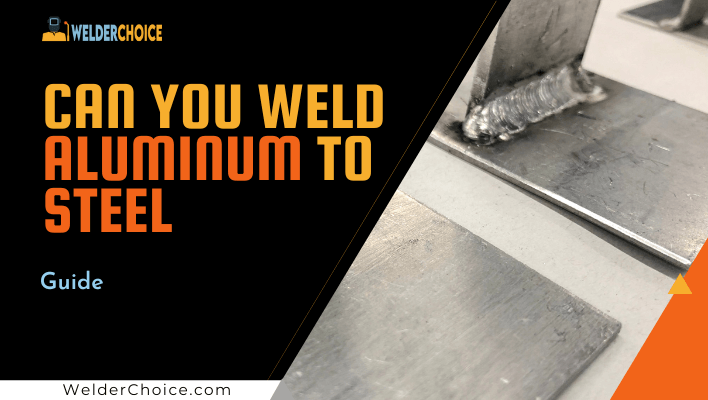You can find the solution of “Can You Weld Aluminum To Steel” Steels have a density of 7.75 to 8.05 g/cm3, whereas Aluminum and its alloys have a density of 2.7 g/cm3, making them significantly more robust. In other words, aluminum weighs three times less than steel for a given amount.
Steel is employed in almost every industry for a variety of structural purposes. As a result, the usage of steel has an unusual weight consequence dependent on its thickness. Current environmental regulations are pressuring businesses to comply with strict greenhouse gas emission limits.
One key way to reduce emissions is to reduce the mass of the vehicle’s structure. Aluminum alloys are now widely used in industry in many ways. It is impossible to replace the entire steel structure with aluminum alloys in most circumstances. As a result, the two metals must be repaired.
Steels and aluminum alloys can be joined using metal brazing or mechanical fasteners like stud welders and adhesive bonding. Welding, on the other hand, is the ideal option when greater structural stability is required. Steel to aluminum alloys welding, on the other hand, is a challenge.
Recommended Post: Best Welder For Aluminum
Why Is It So Difficult To Join Steel And Aluminum?
Steel and aluminum alloys have different physical and metallurgical properties, such as melting temperature and heat conductivity. Steel melts at 1370 degrees Celsius, two degrees higher than aluminum, which melts at 660 degrees Celsius.
These metals are nearly impossible to dissolve into one another due to their widely differing melting points. When two metals react in the molten state, brittle intermetallic phases form. As a result, it’s evident that the issues stated above can cause problems when fusion welding aluminum and steel arc welding.
Welded seams have inferior characteristics, and their brittleness prevents them from being used in most industrial applications.
How Do You Join Steel And Aluminum?
Fusion welding, the process of joining aluminum and steel, is notoriously difficult. This is the case because of differences in expansion coefficients, thermal conductivities, metal melting points, and the ability to generate brittle intermetallic compounds.
The use of lasers to produce a joint between aluminum and steel is a reasonable step because a constant brazing environment can be created closely and moved fast to generate a link with little diffusion time to drive the highly intermetallic compound formation.
Bimetallic transition inserts are also an option for reducing intermetallic formation during fusion welding. The attachments, which are made up of one part steel and the rest aluminum, are joined using friction welding, explosion, flash welding, high-pressure welding, and rollers.
Individually weld the bimetallic transition connection to the bulk steel and aluminum. Because once a significant amount of steel is arc welded to the steel part of the transition attachment, the largest size aluminum is secured to the aluminum section of the transition attachment first, this activity results in the highest heat decrease.
While welding the two metals, the main goal is to keep the welding temperature low while reducing the amount of time the weld is exposed to high temperatures. Bimetallic couplings between steel bulk and aluminum alloy components, for example, require friction welding.
Rotary friction welding, on the other hand, is a solid-state joining method that uses compressive axial force to spin one work component to the other. The heat generated by the contact between the surfaces causes the surrounding things to plasticize.
The plasticized objects are then moved away from the border by the compressive strength, making metallurgical repairing processes easier. If you do not process the friction weld in liquid form, it will remain very cold. Friction welding also cuts down on the amount of time the weld spends in difficult environments. Friction welding is especially helpful for joining a variety of metals since intermetallic compound formation is significantly decreased.
Regardless of whether friction welding is useful for decreasing intermetallic occurrence between steel and aluminum alloys, parameter selection should be done with prudence. When bonding an aluminum alloy to stainless steel, an interlayer of clean aluminum is typically applied, substantially reducing intermetallic formation.
Friction between aluminum alloys and welded steels produces iron-aluminum-based intermetallic complexes. As a result, there is speculation that the sensitive components will be made entirely of aluminum and steel, although this is not the case.
Natural aluminum is more durable than aluminum alloy in general. In other words, when compared to aluminum alloy, the temperature required to move and weld pure aluminum is far lower. These low temperatures are necessary because they prevent brittle compounds from forming.
Most commercial activities for connecting steel and aluminum alloys employ mechanical fasteners due to the difficulty of establishing strong welds between these metals. When using commercial clasps, take the required precautions based on the activities to avoid galvanic corrosion of the aluminum alloy, such as rust. Getting rid of this is straightforward. Simply use aluminum alloy insulation to separate steel from metal paint or insulating coatings.

With 8 years of experience a senior welding instructor and safety equipment researcher and writes articles, reviews and guidelines on helmets and other welding and safety gears at Welder Choice, and other written works have been published in various publications.
